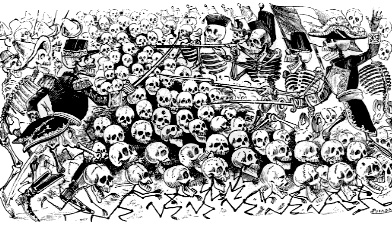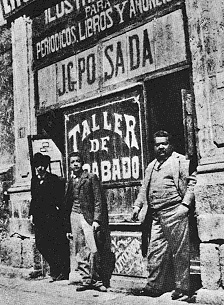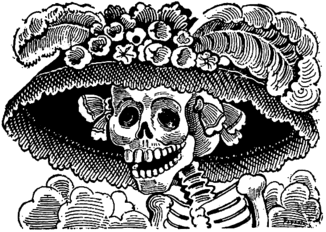|
| |
Mexican Artist: Jose Guadalupe Posada, 1852-1913

Calaveras del Cinco de Mayo by Jose Guadalupe Posada
Jose Guadalupe Posada, 1852-1913
Printmaking in Mexico was stimulated early in the nineteenth century with the advent of lithography (lithography is a method for printing on a smooth surface. It can be used to print text or artwork onto paper or another suitable material.), and critical-satirical genre began to develop. Beginning with Gahona, who took the alias of “Picheta”, political satire flourished in the newspapers of the time. At the close of the 19th century in Mexico City, working with the editor Vanegas Arroyo, Manuel Manilla, and Jose Guadalupe Posada were communicating with truly popular images.

Jose Guadalupe Posada in front of his workshop
Born into a peasant family in Aguascalientes on February 2, 1852, Posada studied the craft of lithography in the workshop of Don Trinidad Pedroza. At the age of twenty he was already know for his illustrations in the Sunday paper “El Jicote” (The Wasp, 1871). After 11 issues the magazine was closed down by the authorities and Posada was forced to flee with his employer to the city of Leon in Guanajato, Mexico. There he carried on a largely commercial printmaking business until 1887 when the terrible floods, coupled perhaps with limited opportunities, caused him to move to the Distrito Federal (Mexico City).
Posada, probably more than any other 19th century artist/engraver/illustrator in the country of Mexico, was able to understand the authentic popular tradition and adapt it with a broad vision to his own time. On thousands of type-metal or zinc plates he expressed the daily life of Mexico in songs, ballads, events, fables, stories, and moral examples derived from atrocities. Among his most famous creations are his Calaveras (skeletons). His Calaveras combined both Mesoamerican cultures with the Spanish heritage of Mexico.
Despite his popularity of his Calaveras and the influence he had on the Mexican muralists of the early 20th century, Posada died in poverty in Mexico City on January 20, 1913.
Museo Nacional de la Estampa in Mexico City
Av Hidalgo 39
Tel: 55 21 22 44
10am-6pm, Tue-Sun. (Sunday Free)
Estampa means "engraving" or "printing," and this museum is devoted to understanding and preserving the graphic arts. The beautifully restored 16th-century building holds both permanent and changing exhibits. The museum is dedicated to the history of the Mexican graphic arts, from Mesoamerica (pre-Columbian) to modern times.

Calaveras de la Catrina
The best-known artist on display is artist/engraver/illustrator Jose Guadalupe Posada. His enduring image of "La Calavera Catrina" (dressed in bourgeois finery, mocks the pretensions and vanity of the living) is among the most familiar representation of the Mexican fascination with death. Posada’s work was featured in the popular satirical newspaper of his day.
|
|
|
|




